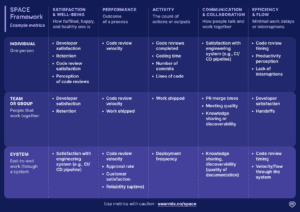In recent years there have been many development frameworks that aim to help software developers streamline their processes and achieve better outcomes. Two of these frameworks are DORA (DevOps Research and Assessment) and SPACE.
In this post we take a closer look at both DORA and SPACE and how the two are complementary.
DORA was started by Gene Kim, Jez Humble and Dr Nicole Forsgren in 2014 and is the ‘largest and longest running research program… that seeks to understand the capabilities that drive software delivery and operations performance.’ (https://dora.dev/)
As their name suggests they focus on researching and providing insightful data though their annual ‘State of DevOps report’. In addition, they outline a framework of four essential metrics to assess a team’s performance on the ‘DevOps capability’ scale, and what areas that need more work. You can take the DORA DevOps Quick Check here in less than a minute (https://dora.dev/quickcheck/).
The metrics that are assessed through this online multiple choice test are:
- Deployment frequency: How often your team is successfully deploying code to production?
- Lead time for changes: How much time does it take for committed code to reach production?
- Change failure rate: What percentage of changes to code result in deployment failures or bugs requiring patches, rollbacks or other hands-on fixes?
- Time to restore service: How long does it take to restore normal services in the event of incidents that impair users?
According to the team behind DORA it helps development teams:
- improve outcomes
- measure performance
- identify capabilities for improvement
However, these metrics might seem somewhat brief to you to determine the performance of an entire department and the individuals within it. And we tend to agree. As we’ve discussed in previous blogs, there are many metrics and factors – technical, organisational and humanistic – that determine the success of a development team. The DORA framework has been criticised for oversimplifying productivity measures and risking neglecting the people behind the numbers.
However, this is where the SPACE framework comes in.
‘The SPACE of Developer Productivity’ was formed in 2020-2021 by Nicole Forsgren (GitHub), Margaret-Anne Storey (University of Victoria) and Maddila, Zimmerman, Houck and Butler (Microsoft Research).
The SPACE Framework takes a big picture approach to developer productivity. It focuses on five dimensions which development teams and tech businesses are encouraged to approach with a proactive and practical mindset based on the reality of their team. These dimensions are:
- Satisfaction and wellbeing
- Performance
- Activity
- Communication and collaboration
- Efficiency and Flow
Each of these can be applied to different aspects of the developer team including the individuals, the team or group, and the system. This table explains it in more detail:-

SPACE provides a more holistic and balanced approach to assessing capabilities, and a comprehensive guide to measuring these with data that is available to an organisation in the present and what might be available in the future.
In a talk given last week to the DORA community (March 23rd 2023)*, Dr. Nicole Forsgren explains the complementary signal and action nature between DORA and SPACE respectively:
“Once you’ve identified the capabilities you want to improve (using DORA), you can use SPACE to identify how you want to measure it.” – Dr Nicole Forsgren
We highly recommend watching this presentation and if you haven’t done so already, exploring how the DORA and SPACE frameworks may benefit your software development team.
DORA and SPACE offer a valuable comprehensive methodology for organisations looking to improve their outcomes by streamlining processes, increasing collaboration, speeding up delivery and ensuring developers are kept positive.
*Link to presentation delivered by Dr. Nicole Forsgren to the Dora Community: “SPACE & DORA: One big happy family” https://www.youtube.com/watch?v=HnKjouazi3k&list=PLKK5zTDXqzFNt1OTjhlrCnhVl1UO2QMbk&index=13
Questions & Answers About DORA and SPACE Frameworks
How can organizations effectively integrate DORA and SPACE frameworks into their existing development processes, especially if they are currently not using any formal framework?
Integrating DORA and SPACE into an organization’s development process can initially seem like a daunting task, especially for teams not already following a structured framework. The key to a smooth integration lies in starting small and focusing on one framework at a time. Begin by assessing current practices against the DORA metrics to identify areas for immediate improvement. Once these improvements start to take shape, gradually introduce SPACE dimensions to further enhance team dynamics and productivity. Encourage team discussions and workshops to ensure everyone understands the value and purpose behind each framework. This phased approach allows for gradual adaptation and minimizes disruption to ongoing projects.
How do DORA and SPACE address the challenges of remote and distributed teams, especially considering the increased emphasis on remote work?
Addressing the unique challenges of remote and distributed teams, both DORA and SPACE offer frameworks that are inherently flexible and adaptable to various work environments. DORA’s emphasis on metrics like deployment frequency and time to restore service is just as relevant for remote teams, where clear, measurable goals are crucial for coordination. Similarly, SPACE’s focus on satisfaction, well-being, and communication is vital in a remote setting, helping to ensure that team members feel connected and valued despite physical distances. By emphasizing these aspects, both frameworks naturally cater to the nuances of remote work, promoting a culture of continuous improvement and collaboration that transcends geographical boundaries.
Further Reading: https://newsletter.pragmaticengineer.com/p/developer-productivity-a-new-framework



